Stain removal techniques: Tips to remove metals from the water and prevent future pool discolouration
by habiba_abudu | January 24, 2020 10:59 am
By Rob Kamstra
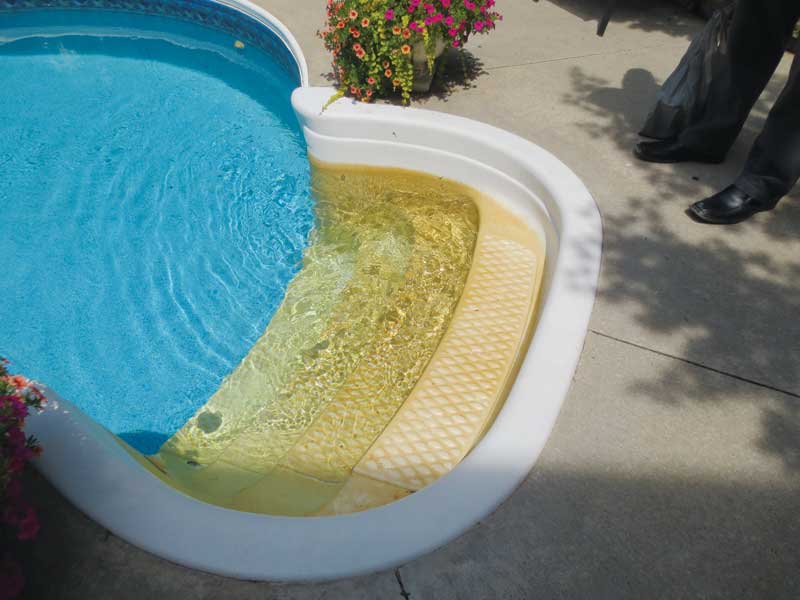 [1]
[1]Metal stains in pools are unattractive and can be a distraction from their desired appearance. Not only are these unsightly blemishes difficult and expensive to diagnose and remedy, but they can also be nearly impossible to remove. Generally, no great amount of scrubbing and cleaning will fix the problem, which can be extremely frustrating for homeowners.
The presence of metals in water is, in fact, the heart of the issue. The most common metals that cause discolouration are iron and copper and, to a lesser extent, manganese. Stains, however, can also be caused by scale formations, organic deposits (e.g. pollen), and even algae (both green and black). Pink slime (a bacterial growth) is also a possibility, so is mould. They can cause liner discolourations and even grow behind the liner and show through.
That said, it is not uncommon for stains to be misdiagnosed when there are a host of possible causes. The key to finding a long-term solution is to determine where the metals in the water are coming from. Typically, metals can be found in areas such as well water, copper-based algaecides, ionization systems, pool heaters, copper piping, valves, and other metal parts. To prevent these metals from staining the pool surface, service techs should follow a few steps.
Test
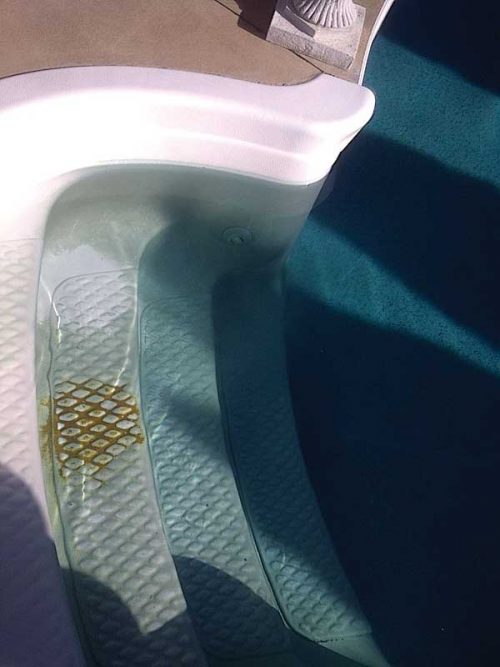 [2]
[2]To identify the stain type, one must determine the metal present in the pool water and further test it to see if it can be lifted from the surface of the vessel. A water test is usually a good starting point to check for higher levels of iron, copper, or manganese. But remember, the metals may no longer be in the water if they have already oxidized or plated onto a surface.
Topical testing is the most accurate way to determine the metal type and whether or not the stain can be lifted from the water surface. The author recommends two testing techniques:
- Technicians can use a specialized stain identification kit. Some consist of three different product pouches that can remove tough stains or scale. Each pouch—whether it is used individually or in combination—will remove a different stain type.
One must remember to test the pool water prior to using the kit to ensure optimum water ranges (chlorine, pH, total alkalinity [TA], total dissolved solids [TDS], temperature, etc.) for stain removal. If necessary, the water can be adjusted in a localized area on-site, as opposed to the entire pool.
The pump must be turned off to stop water movement. This ensures accurate results as circulating water can dilute and move the sample products applied to the water. Reasonable water temperatures are mandatory as part of the testing process. Readings may not be precise and may give a false negative result if the water is too cold. Higher amounts of chlorine can break down the test products and affect their performance; therefore, low chlorine levels are recommended. Also, lower pH and TA can enhance test reaction times.
Service techs should begin the test by applying a portion of the pouches in a localized area (where there is a stain) and observe to see if the product can lift the stain off the surface of the water. The first pouch removes iron and cobalt, while the second removes copper and scale. Sometimes, the stain removal process can be very quick. Other times, it can be slower, and take up to 45 seconds to show any marked result. The last pouch is an oxidizer that can make a metal stain noticeable at once, making it appear significantly worse. At first, one may think they have done something wrong, but this only means the pouch’s contents have fully oxidized the metal into a form that is easier to remove. Returning to one of the pouches used earlier will then determine if the stain can be removed in its fully oxidized form. Note: Service techs can even apply individual pouches in different scenarios to see if a combination helps lift the stain from the surface.
-
 [3]
[3]Another easy technique is to use an uncoated vitamin C tablet, which consists of ascorbic acid. When the tablet is placed in the middle of a stained area, it will leave a ‘cleaned-up’ spot. Another easy technique is to use an uncoated vitamin C tablet, which consists of ascorbic acid. This method works well to remove iron stains. When the tablet is placed in the middle of a stained area, it will leave a ‘cleaned-up’ spot. Specialized citric acid products can also be used to lift the stain. However, service techs must remember these products are affected by high chlorine levels, so they should adhere to the maximum chlorine level recommendations on the label.
Protect
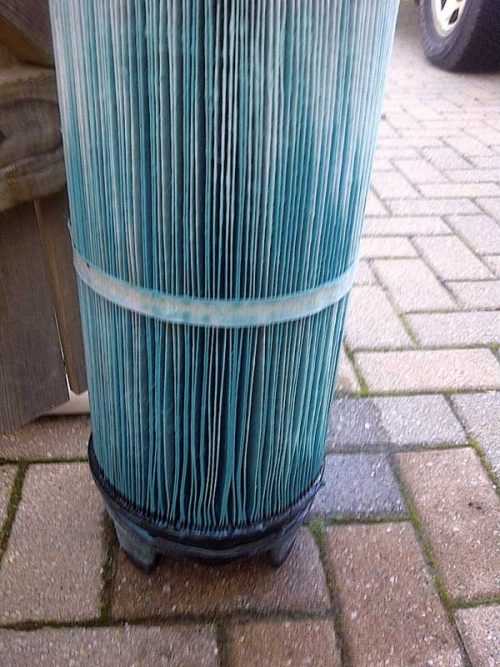 [4]
[4]Once service techs are able to identify the product that can successfully lift the stain, they can safely use the product for removing the discolouration. As metal stains are removed from the pool surface, the metal ions will re-absorb into the water. Therefore, the metal will need to be removed from the water, but first technicians should take measures to prevent the metal from re-staining the pool surface.
Using a sequestering agent can prevent stain and scale formations. These products are designed to find certain dissolved metals and minerals and pull them into similar groups. Once sequestered, they are unlikely to be able to re-stain onto a surface. Sequestering agents can also help in the stain removal process. Pool techs must use products depending on the metal that needs to be removed from the water—whether it is iron, scale formations, or copper. Adding one of these products in the beginning is a critical step in the stain removal process. This ensures once the stain is removed, the sequestering agent is present in the water, ready to catch hold of the metals and prevent them from turning into stains again.
Lift
The stain removal product that worked best in the testing phase can now be applied. Service techs must ensure they follow the label directions as many products require special water balance parameters to work effectively. Note: Copper and scale formations require products with a very low pH and TA. For this method, one should install a heater bypass, which is designed to remove copper, to avoid damaging the copper heater core. Prepare the pool water to the recommended parameters and then apply the removal product(s) based on the process instructions and the pool’s volume. This technique removes metal stains from the pool surface. Further, the sequestering agent prevents the metals that have been removed from re-staining the surface.
Remove
Removing metals from the water can be tricky. That said, there are several products on the market that can help in this process. Cellulose fibre chemicals work very well with sand filters. They can also be used with cartridge and diatomaceous earth (DE) filters, but it is more difficult to use. Frequent cleaning of cartridges is also required. The chemical is applied to the skimmer and makes its way into the filter to rest on the bed of sand. The solution changes into a substance that will quickly trap metals as they flow through the filter, but will also absorb and filter everything else out of the water, including finer debris. This technique makes the water cleaner and removes metals, but can increase filter pressure quickly. When the filter pressure rises, service techs should backwash and re-apply the solution. This process should be repeated until the metal residual has disappeared.
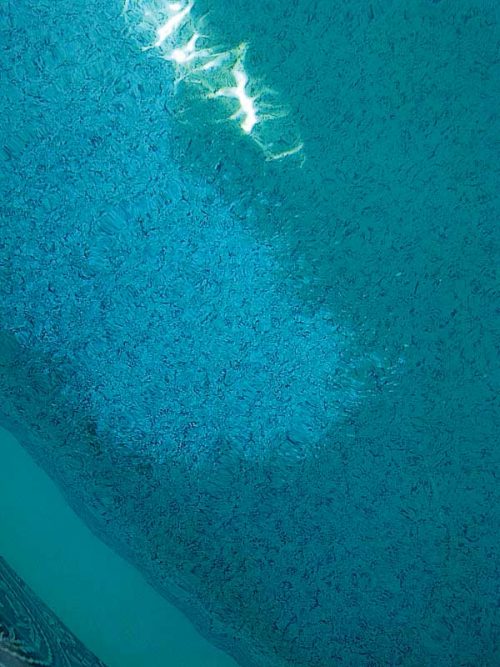 [5]
[5]Another effective method to remove dissolved metal ions from the water is to use an eliminator, which ‘catches’ metals and prevents staining and scaling. This product’s performance is slightly slower compared to cellulose fibre chemicals, but it can remove all the metals from the water. The eliminator comes in a small pouch and contains a unique compound that absorbs metals as they flow by. For best results, the pouch should be secured inside a special plastic cage and then placed in the pump basket. Alternatively, the pouch can be placed in the skimmer basket. One advantage of using an eliminator is it can sit in the pump or skimmer for weeks/months at a time. This aids in the continuous removal of metals, keeping the water clean as long as the pouch is in use. Once the pouch is full, it can easily be replaced with a new one.
One must remember metals can stay hidden away in the filter media. If these are not cleaned properly, the metals can make their way back into the pool water. In this case, it is recommended the filter media is washed regularly with a specialized cleaner to prevent unwanted reintroduction.
Prevent
The key to effective stain removal is to identify the source of the metals to prevent further introduction. To do this, pool techs must conduct a thorough investigation and come up with appropriate solutions. If copper is present in the water, check the water balance to see if corrosion is the problem (usually the heater core starts dissolving as a result of overly acidic water). This could also be due to the addition of algaecides or from the fill water. Iron usually comes from the fill water or poor quality products (pool salt, balancing products, etc.).
Ongoing prevention by using a quality sequestrant and metal eliminator can help prevent future stain issues when the source of metals cannot be found or prevented (as in the case of fill water).
 [6]Rob Kamstra has more than 30 years of experience in the pool and hot tub industry and is the director of business development for Backyard Brands Inc. He is the past president of the Pool and Hot Tub Council of Canada (PHTCC) and has supported the council in several areas, including marketing and business education. Most recently, Kamstra rewrote the basic and advanced industry chemistry courses. He has been a frequent and sought-after conference presenter throughout the industry on both chemical and business/marketing topics. He can be reached via e-mail at rob.kamstra@backyardbrands.com.
[6]Rob Kamstra has more than 30 years of experience in the pool and hot tub industry and is the director of business development for Backyard Brands Inc. He is the past president of the Pool and Hot Tub Council of Canada (PHTCC) and has supported the council in several areas, including marketing and business education. Most recently, Kamstra rewrote the basic and advanced industry chemistry courses. He has been a frequent and sought-after conference presenter throughout the industry on both chemical and business/marketing topics. He can be reached via e-mail at rob.kamstra@backyardbrands.com.
- [Image]: https://www.poolspamarketing.com/wp-content/uploads/2020/01/iron-steps.jpg
- [Image]: https://www.poolspamarketing.com/wp-content/uploads/2020/01/IMG-20120829-01670.jpg
- [Image]: https://www.poolspamarketing.com/wp-content/uploads/2020/01/IMG-20120829-01671.jpg
- [Image]: https://www.poolspamarketing.com/wp-content/uploads/2020/01/IMG-20120829-01676.jpg
- [Image]: https://www.poolspamarketing.com/wp-content/uploads/2020/01/IMG-20120829-01675.jpg
- [Image]: https://www.poolspamarketing.com/wp-content/uploads/2020/01/Kamstra_Headshot.jpg
Source URL: https://www.poolspamarketing.com/trade/features/stain-removal-techniques-tips-to-remove-metals-from-the-water-and-prevent-future-pool-discolouration/
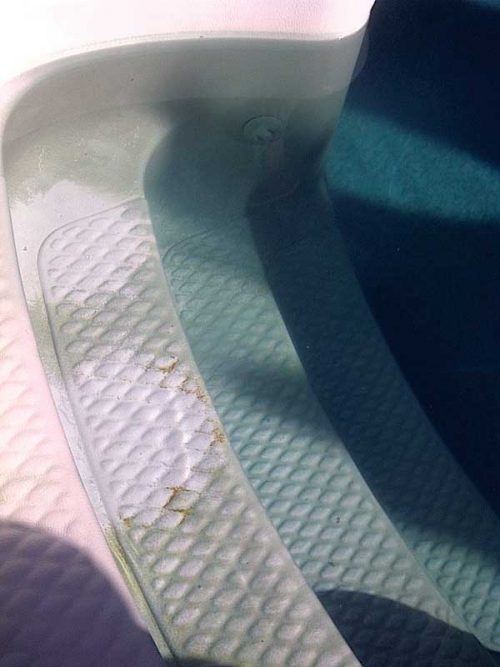 [3]
[3]